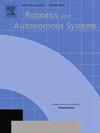Management of a fleet of autonomous underwater gliders for area coverage: From simulation to real-life experimentation
IF 4.3
2区 计算机科学
Q1 AUTOMATION & CONTROL SYSTEMS
引用次数: 0
Abstract
This article deals with underwater gliders whether there are operated in a fleet or individually. They constitute the most affordable and energy-saving autonomous observation/data acquisition platform, making long-duration ocean exploration missions possible. In this article, theoretical researches are led to solve the path planning problem of multi-point exploration missions of this type of vehicle. We focus on the area coverage type missions i.e. all points of a given area must be visited only once. We suggest a new path planning method for area coverage i.e. the fleet of glider is sized and the optimized glider trajectories are calculated according to selected criteria (mission duration, energy consumption or traveled distance). Our proposed approach combines weighted graph theory with our underwater glider simulator whose main interest is to be capable of integrating time-varying 3D environmental data (4D). Our method is tested in simulation and then in a dynamic real-life context (Mediterranean Sea) on Alseamar’s SeaExplorer autonomous underwater gliders. Finally, a comparison with the expertise of a glider pilot and a more conventional approach, exploiting only the distance between the waypoints in the operation area, confirms the relevance and effectiveness of the suggested method. The experimental mission demonstrates the interest and benefits of the approach and the ease of operational implementation in an industrial context.
管理用于区域覆盖的自主水下滑翔机舰队:从模拟到实际实验
本文论述的是水下滑翔机,无论是以船队形式运行还是单独运行。它们是最经济、最节能的自主观测/数据采集平台,使长时间海洋探测任务成为可能。本文通过理论研究来解决这类飞行器多点探测任务的路径规划问题。我们将重点放在区域覆盖型任务上,即必须只访问一次给定区域的所有点。我们提出了一种新的区域覆盖路径规划方法,即根据选定的标准(任务持续时间、能耗或飞行距离)确定滑翔机队的规模并计算优化的滑翔机轨迹。我们提出的方法将加权图理论与我们的水下滑翔机模拟器相结合,该模拟器的主要功能是整合时变三维环境数据(4D)。我们的方法首先在模拟环境中进行了测试,然后在 Alseamar 公司的 SeaExplorer 自主水下滑翔机的动态真实环境(地中海)中进行了测试。最后,通过与滑翔机驾驶员的专业知识和仅利用作业区航点间距离的传统方法进行比较,证实了所建议方法的实用性和有效性。实验任务证明了该方法的意义和优点,以及在工业环境中操作实施的便利性。
本文章由计算机程序翻译,如有差异,请以英文原文为准。
求助全文
约1分钟内获得全文
求助全文
来源期刊

Robotics and Autonomous Systems
工程技术-机器人学
CiteScore
9.00
自引率
7.00%
发文量
164
审稿时长
4.5 months
期刊介绍:
Robotics and Autonomous Systems will carry articles describing fundamental developments in the field of robotics, with special emphasis on autonomous systems. An important goal of this journal is to extend the state of the art in both symbolic and sensory based robot control and learning in the context of autonomous systems.
Robotics and Autonomous Systems will carry articles on the theoretical, computational and experimental aspects of autonomous systems, or modules of such systems.
 求助内容:
求助内容: 应助结果提醒方式:
应助结果提醒方式:


